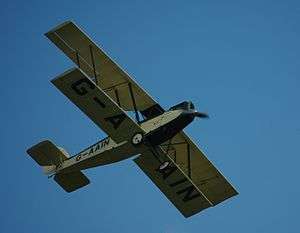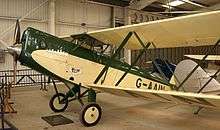Parnall Elf
The Parnall Elf is a British two seat light touring aircraft of the 1920s. Built by George Parnall & Co. the Elf was the last aircraft designed by Harold Bolas before he left the company to go to the United States.
| Elf | |
|---|---|
 | |
| Role | Two-seat light aircraft |
| Manufacturer | Parnall & Co |
| Designer | Harold Bolas |
| First flight | 1929 |
| Number built | 3 |

Design and development
The Parnall Elf was designed by Harold Bolas, chief designer of the reformed George Parnall & Co. The type made its public debut at Olympia in July 1929.[1] The Elf was a biplane of wood and fabric construction with staggered wings set well forward on the fuselage as a feature to assist crew escape in an emergency. The wings were unusually braced with 'vee' interplane struts which dispensed with any flying wires[1] and could be folded for ease of hangarage. The main fuel tank was fitted in the fuselage, while a pump raised the fuel to a small tank in the wing centre section where it was then fed to the engine by gravity. An Elf placed fifth in the 1930 King's Cup Air Race out of a field of 88 entrants. The purchase price of the aircraft at this time was between £875 and £890.[2]
Survivors
- Parnall Elf, G-AAIN, is maintained and operated by the Shuttleworth Collection in Bedfordshire, England and may be flown regularly throughout the summer months. 'G-AAIN' flew at the "At The Movies" Drive-In airshow on 2nd August 2020, hosted by the Shuttleworth Collection
Specifications (Elf Mk.II)

Data from Parnall Aircraft since 1914[3]
General characteristics
- Crew: 2
- Length: 22 ft 10.5 in (6.972 m)
- Upper wingspan: 31 ft 3.5 in (9.538 m)
- Lower wingspan: 26 ft 9 in (8.15 m)
- Width: 7 ft 2 in (2.18 m) folded
- Height: 8 ft 6 in (2.59 m)
- Wing area: 195 sq ft (18.1 m2)
- Empty weight: 900 lb (408 kg)
- Gross weight: 1,700 lb (771 kg)
- 1,500 lb (680 kg) for aerobatics
- Fuel capacity: 21 imp gal (25 US gal; 95 l) in a fuselage main tank and centre-section gravity tank
- Powerplant: 1 × Cirrus Hermes II 4-cylinder air-cooled in-line piston engine, 120 hp (89 kW)
- Propellers: 2-bladed fixed-pitch propeller
Performance
- Maximum speed: 116 mph (187 km/h, 101 kn) at sea level
- 112 mph (97 kn; 180 km/h) at 5,000 ft (1,524 m)
- Cruise speed: 103 mph (166 km/h, 90 kn)
- Stall speed: 40 mph (64 km/h, 35 kn)
- Range: 400 mi (640 km, 350 nmi)
- Service ceiling: 16,000 ft (4,900 m)
- Rate of climb: 800 ft/min (4.1 m/s)
- Time to altitude: 10,000 ft (3,048 m) in 21 minutes
References
- Ogilvy, 1989.
- Guttery, 1969. p. 43.
- Wixey, Kenneth E. (1990). Parnall Aircraft since 1914. London: Putnam Aeronautical Books. pp. 181–189. ISBN 978-1-55750-930-7.
Bibliography
- Guttery, T.E. The Shuttleworth Collection. London: Wm. Carling & Co, 1969. SBN 901319-01-5
- Ogilvy, David. Shuttleworth – The Historic Aeroplanes. Shrewsbury, England: Airlife Publishing Ltd., 1989 ISBN 1-85310-106-0
External links
| Wikimedia Commons has media related to Parnall Elf. |
- Parnall Elf – British Aircraft Directory
- Elf in Flight, 4 April 1930